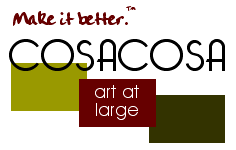



Just as design is often seen as an afterthought for new technologies, art is often seen as superfluous to the more quantifiable work behind social change and the rhetorical and charismatic qualities of change leaders. But anyone who has studied the history of social movements knows that art and media have always played a role, from political posters to buttons to films and music.
A recent essay by Favianna Rodriguez at Creative Time Reports caught my eye. Rodriguez, who co-founded the immigrant rights organization and magazine CultureStrike with Jeff Chang, Ken Chen, and Andrew Hsiao, argued for the need for “cultural strategy” or “cultural organizing” as a key, deliberate component of social movements:
As artists, we need to communicate more than what we stand against or why particular policies affect us negatively, because limiting our commentary to such reactions would confine the social imaginary to existing political frameworks and systems that we do not control. We should also present our vision for who we are, and show why that vision is a positive one. Working in the realm of ideas does not take energy away from the action space. Cultural strategies are as necessary as political strategies.
She makes a distinction between cultural strategy and communications strategies. And this is where artists have a unique opportunity contribute. Artists can imagine and visualize a message that’s not necessarily about action but more about shifting narratives and imagery: “The idea space presents more complex messages. It allows us to deal with contradictions and gray areas.” Art, she argues, is central to social and political change, not peripheral.
It got me thinking about another essay I read recently in Design Observer that looks at political posters in recent history (I wrote last year about posters of protest from the 1960s and 70s). While collection and organizing these posters is a beautiful study in political art and the power of visual rhetoric, the author, Rick Poynor, highlights a major hurdle for anyone trying to present them:
The curatorial challenge is to convey to the viewer, who may know nothing about the original context of any of these posters, and may have only the vaguest impression of the causes and passions behind them, that they represent moments of refusal, resistance and hope for necessary change.
He’s right — behind these posters is a lot of risk, a lot of change. Far from abstract images, they are a living part of history. Both essays are a good reminder of art’s centrality to social change, to the upheavals and shifts of society. Art is not just a mirror; it’s also part of the driving force.
An Xiao Mina writes about art and social change, with a focus on new media and global art practices. As an artist, she has shown her photographs, installations, and performance work in publications and galleries internationally. As a technologist, she researches the social translation of social media and is co-founder of The Civic Beat, a collective exploring the creative side of civic technology. She also serves as an advisory editor for Hyperallergic, where this essay was published in May 2015.